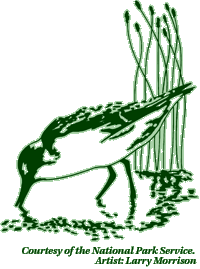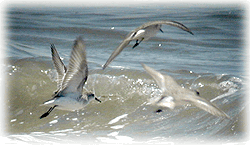 |
|
|||
Objectives Students will be able to:
Migration cards Lined paper Pencil or pen Stickers with an X Making Connections Students will understand the stresses of migration and the influence of both human and natural events on the survival of individuals and species. Background Migration facts used in the Migration Game are based on the article The Incredible Flying Machines; the Incredible Journey, Paul Kerlinger, New Jersey at the Crossroads of Migration, NJ Audubon Society, 1989. The following is pertinent information from the article. Birds fail to complete migration for a variety of reasons. Natural causes can include starvation, competition, disease, storms, and predation. Human causes include collision with human-made objects such as high-tension wires and buildings, hunting, oil spills, and destruction of habitat needed to support the birds. A combination of natural and human factors can be devastating to the bird in migration. Young birds on their first flight are at greatest risk of mortality. Some birds do not migrate at all while others migrate more than 25,000 kilometers. Migration distances vary within species. One bird may migrate from the tip of South America to Hudson Bay. Another bird of the same species may start in Florida and end on the same island. The longer the flight, the greater the opportunity for something to go wrong. In order for a species to survive, birth rates and death rates need to be at least equal. When death rates exceed birth rates, a species is in trouble, especially if this trend continues over a period of years. For a bird, failure to reproduce in a season is the same as death to the species since there will be no offspring from that individual. Birds may fail to reproduce for several reasons. Birds that reach mating grounds late will lose out in the struggle to find safe nesting sites. A precariously perched nest can be destroyed or subject to predation. Late birds may also be unable to find mates. Late broods that survive to migration will have immature fledglings who will likely be lost during the migration to southern resting grounds. Some birds may be so weakened by migration, that they are unable to continue to mating grounds. Some experts believe that successful nesting and mating requires certain foods available only in certain habitats. A shorebird may spend the summer in the Hackensack Meadowlands, but be unable to find the food needed for breeding. To the species, this is the same as if the bird had died. Where a bird stops along the migration route can influence weight gain. Louisiana is a richer source of nutrients than the nearby barrier islands of Mississippi. Therefore, an exhausted bird making land fall in Louisiana will have a better chance of “bulking up” than the bird landing in Mississippi. Weight gain is phenomenal. Fat is the key to maintaining long migratory flights. A shorebird may gain two to five percent of its body weight each day during a migratory stopover. At the Delaware Bay, shorebirds are estimated to gain 50% of their body weight consuming horseshoe crab eggs before continuing on to northern breeding grounds. Procedure Warm Up Ask students for some examples of things that could influence the survival of shorebirds during migration. Explain that they will be assigned to “Flocks” and playing the role of a migratory shorebird. At the end of the activity students will be asked to write about their flight and assess the survival of their species. The Activity Photocopy the migration cards. Tape or glue them onto index cards. Write the number of the event on the back of the index card. Arrange them down the hallway in order. Allow plenty of space between cards. Divide students into 6 groups. Start student groups at cards 1-6. Each group will follow the directions and move along the cards in a different pattern. When students return from their migrations, reassign them so that each group has a “bird” from the migration route. (Each group should now have a student who started at card 1, 2, 3, 4, 5, and 6.) On a sheet of lined paper, students should list their migration experiences and calculate their species survival rate. Birds who fail to produce viable offspring are the same as a dead bird to the species. Students may assume that their successful hatches produce four offspring. Wrap Up Have students report their group’s findings. Students should be able to identify the natural and human events that either helped or hindered their migration. Action Students can evaluate the quality of habitat in their community or region. They can use the telephone book to find out the location of wildlife refuges and centers. Students can find out what organizations in their community are active in preservation of habitat for migratory birds. Assessment Evaluate the logic of student group reports. Extensions Contact the NJ Adubon Society for information about the World Series of Birding and other birding events in which students can participate. Please download the PDF for the complete Lesson Plan. New Jersey at the Crossroads of Migration |
|||

 Duration
Duration Materials
Materials